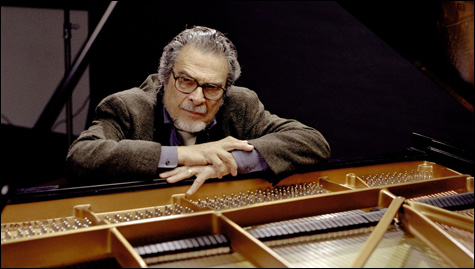
LEON FLEISHER: Could this great pianist play an unmeaningful note if he tried? |
There are lots of references to heaven in Bach’s Passions and cantatas, but one of his most heavenly pieces has no words at all, his Concerto for Violin and Oboe — a reconstruction of a surmised “original” version of his great D-minor Concerto for two harpsichords. One moment I always listen for comes in the opening bars, before either of the soloists enters. It’s a rocking theme in the strings — two notes up, two notes down, seesawing back and forth twice (DUM-dee-DEE-dum, DUM-dee-DEE-dum); then six notes rise up to another falling two-note motto (DUM-dee-dee-DUM-dee-dee-DEE-dum), after which Bach repeats these last two notes, a little echo. We know it’s an echo because later in the movement, when this opening is repeated, instead of strings, the oboe comes in to echo that falling two-note phrase. I love it when an orchestra, through subtle modulations of rhythm and dynamics, suggests that little echo effect in the opening bars.
In the Cantata Singers’ season-ending concert, which featured this concerto, two Bach choral pieces, and the premiere of a new work with chorus and oboe by Stephen Hartke, I didn’t hear David Hoose — a conductor usually alert to such nuances — convey that opening echo effect. There was, of course, plenty to admire in the performance, most of all Peggy Pearson’s playing of the oboe part (complete with echo). Violin soloist Danielle Maddon, the Cantata Singers’ superb concertmaster, had to scramble a little to keep up with Hoose’s zippy tempos, and the balance between violin and oboe tended to favor the oboe. I’d have liked the sublime central Adagio to have been a little more expansive, more adagio. Still, most of this performance was on the highest musical level.
The other Bach pieces were Cantata No. 161, Komm, du Süße Todesstunde (“Come, you sweet hour of death”), with its sweet pair of flutes, and the exuberant “Ascension Oratorio,” Himmelfahrts-Oratorium (BWV 11), the opening and closing movements of which, with their brilliant trumpets and drum, were incisive and thrilling.
I remember a time when I didn’t much care for Bach’s cantatas —before I heard Craig Smith lead them on Sunday mornings at Emmanuel Church; before Peter Sellars collaborated with Smith on staging one with Sanford Sylvan and two others with Lorraine Hunt Lieberson; before I heard Sarasa, or John Harbison and David Hoose lead the Cantata Singers. In short, before I heard musicians play and sing as if the cantatas were of urgent importance (as they were to Bach), not just musical sermons lifelessly intoned — which was how most of the solo singing sounded at this concert. Bass Mark Andrew Cleveland came closest to connecting the music with the text. Tenor Charles Blandy sang with his customary engagement, but in the oratorio he delivered his Evangelist-like recitatives linking the arias and choruses with what sounded more like anger than “with great joy.” Alto Catherine Hedberg sang the “Ach bleibe doch, mein liebstes Leben” (“Ah, stay, my dearest life”), a love song to Jesus whose tune Bach later transformed into the Agnus Dei of his B-minor Mass; the audience liked her singing, but what I heard was more like a mild “Lamb of God” than the passion of Bach’s sacred parody of an erotic lyric. In the cantata, alto Gloria Raymond, in her 22nd year with the Cantata Singers, sang without much energy or inflection, and in the oratorio, soprano Kate Woolf, in her second season, had more energy than vocal finesse.